Kariginu
かりぎぬ 狩衣
A kariginu is a broad-sleeved (ōsode 大袖) noh costume with a round-collar and open cuffs worn as an outer upper garment by high-ranking male characters. Generally decorated with woven patterns, they are draped over divided skirts. Kariginu can be lined (awase) or unlined (hitoe), the former suited to ministers and supernatural beings, the latter to elegant courtiers.
Noh Kyogen
Roles and Draping
Despite the wide range of characters, both human and supernatural, that wear kariginu there is one basic draping: the body panels are bound at the waist so they hang loosely over the belt and the hem covers the top third of the wide divided skirts, which may be ōkuchi (ministers, notably 'waki roles in many first-category plays) or hangiri (supernatural beings, such as the Thunder God in Kamo 賀茂 or the tengu in Kurama Tengu 鞍馬天狗) or sashinuki 指貫 (courtiers, as in Unrin'in 雲林院 and Tōru 融). In addition, an alternative draping involves folding under the round collar so it forms a "V" neck (emon-tsuki), which can be used for energetic roles involving rapid movement, such as the vigorous god of Sumiyoshi in Takasago 高砂. The "V" neck draping combined hiking up the sleeves is an alternative costuming for warrior roles, like the revengeful wraith of Taira no Tomomori in Funa Benkei 船弁慶.
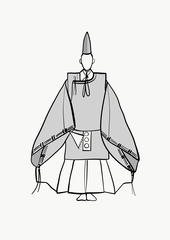
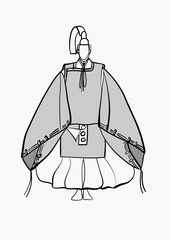
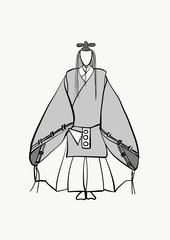
Tailoring
A three-quarter length robe is distinguished by the round collar with overlapping narrow front panels and double-width sleeves open at the cuffs. The seams connecting the sleeves to the center panels are short and mostly at the back, so that the drape over the chest remains independent of the movement of the sleeves.The round collar (sometimes squared off) is a feature shared with court costumes that are based on ancient Chinese styles. Cords attached at the edge of the collar on the left overlapping front panel are used to fasten the collar to the right panel. Other cords are laced through narrow cloth strips along the edge of the sleeves.
Textile Features
Most typically lined kariginu use a solid-ground weave such a satin or twill with gold or silver or colored silk thread supplementary patterning. When gold designs are set against a dark ground, it is common to use an extra yellow or red warp in a lampas weave to hold down the pattern threads so as not to dull their impact. Multi-colored supplementary patterning on twill or satin gives a more refined effect. Figured satin, double weave, and embroidery are alternative decorative techniques. Old kariginu are often made from imported fabrics (meibutsu-gire) or imitations thereof.
Unlined kariginu are woven of thin, gossamer material. They are worn by elegant courtiers, young warrior courtiers who die in battle and aged spirits of plants. The weaves include gold patterning on ribbed gauze weave (rokin), patterning with supplementary colored threads on plain gauze weave (sha) or self-patterned plain gauze weave (monsha). For a more rustic feel, monotone coarse plain weave with displaced wefts (yore) is also possible.
Designs and Coloring
Lined kariginu worn by strong characters tend to have dark solid color grounds such as deep red, indigo blue, or green with large geometric patterns in gold or silver. For aristocratic characters, the ground color might be white or light yellow, or it might have multi-colored smaller repeat patterns. These can be geometric, like the Okina kariginu pattern of interlocking hexagons and squares, but might also be derived from nature, such as flower scrolls. Unlined kariginu tend to be a gentler blue, green, cream, or white and have designs reminiscent of court patterns (yūsoku monyō).
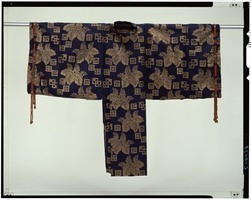
Kariginu with paulownia and scattered squares on a dark blue ground. 18th c. Tokyo National Museum http://webarchives.tnm.jp/imgsearch/show/C0016128
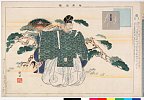
Print showing the Okina kariginu by Tsukioka Kogyō. Part of his nōgaku zukai series published in 1897. ARC archives.
Contributor
Monica Bethe
Kabuki
Private
衣裳の名称。もと狩に用いた衣服だったが、平安朝時代から公家の服となり、江戸時代には模様のある狩衣は大納言以下武家では五位以下の礼服となった。下に指貫(さしぬき)を穿く。これは歌舞伎衣裳にもとり入れられて、官位のある身分の高い役などに用いられる。「仮名手本忠臣蔵」大序の足利直義、「三番叟」の翁など。